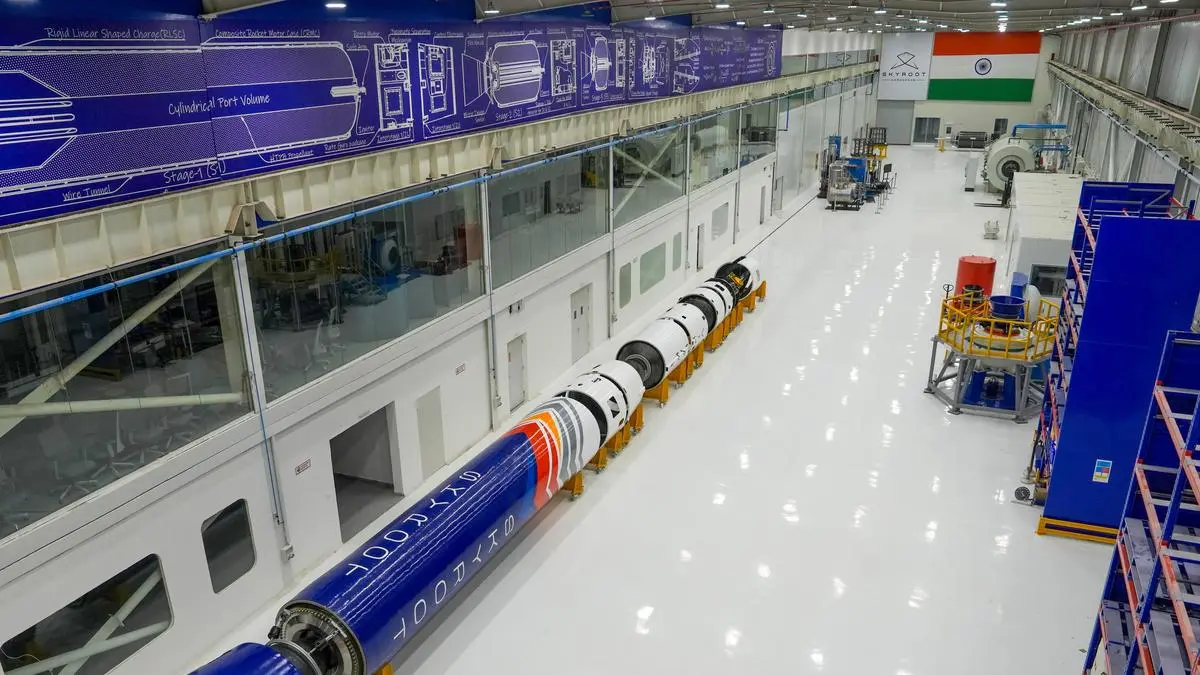Science
Skyroot Aerospace Prepares for Vikram-1 Launch from Hyderabad

Skyroot Aerospace is making significant strides in the private space sector with its preparations for the upcoming launch of the Vikram-1 rocket. The Hyderabad-based company is finalizing its work on this 22-meter launch vehicle, which is scheduled for an orbital launch later this year. The Max-Q Campus, which resembles a futuristic film set, is abuzz with engineers and technicians diligently crafting various components of the rocket, from the nose cone to the fins.
The Vikram-1 rocket stands out due to its innovative design, featuring a seven-storey structure made primarily from carbon composites. This lightweight material is five times lighter than steel and five times stronger than aluminum, according to Pawan Kumar Chandana, Co-Founder of Skyroot Aerospace. The integration of 3D-printed engines is a game-changer, allowing for a reduction in the number of parts from 150 to a single component. This advancement minimizes potential failure points and enhances overall reliability.
Successful Static Test Marks a Milestone
Recently, the Vikram-1 successfully completed a static test-firing of its Stage-1 carbon composite solid fuel booster at Sriharikota. This 30-tonne booster stage validated performance metrics crucial for the upcoming launch. The test data is now guiding a team of approximately 600 employees who are focused on optimizing the rocket’s engine and mission computer, the latter of which serves as the brain of the spacecraft.
The excitement surrounding the test firing was palpable, especially for Anant, a 30-year-old engineer who has been integral to the engine-building team. He expressed pride in the successful outcome, stating, “The feedback from the static test was perfect. A little bit of fine-tuning is required to make it more optimal.” His sentiments reflect the collaborative efforts and expertise shared with veterans from ISRO, India’s national space agency.
Innovative Technology and Future Goals
At the heart of the Vikram rocket’s capabilities lies its sophisticated mission computer, developed by a dedicated team including Spatika, a Kalpana Fellow who specializes in embedded systems. She shared her pride in the recent achievements, noting that the mission computer will “take all of the decisions” during the flight. This component is essential for the rocket’s autonomous operations as it embarks on its mission to deploy multiple satellites into their respective orbits.
The successful launch of the smaller Vikram S suborbital rocket in 2022 marked a significant milestone for Skyroot, showcasing the effectiveness of their technology just two years after the government announced a supportive policy for the private space sector. Pawan Kumar Chandana emphasized that the company is preparing for long-term engagement in the growing $30 billion global launch market, aiming to position itself as one of the select few players in this competitive field.
As Skyroot Aerospace continues to innovate and refine its technology, the upcoming launch of the Vikram-1 promises to be a pivotal moment for the company’s future and for India’s aspirations in the international space arena. The team’s meticulous efforts and groundbreaking approaches to rocket design and manufacturing exemplify the potential of private space exploration in reshaping the landscape of global launches.
-

 World5 months ago
World5 months agoSBI Announces QIP Floor Price at ₹811.05 Per Share
-

 Lifestyle5 months ago
Lifestyle5 months agoCept Unveils ₹3.1 Crore Urban Mobility Plan for Sustainable Growth
-

 Science4 months ago
Science4 months agoNew Blood Group Discovered in South Indian Woman at Rotary Centre
-

 World5 months ago
World5 months agoTorrential Rains Cause Flash Flooding in New York and New Jersey
-

 Top Stories5 months ago
Top Stories5 months agoKonkani Cultural Organisation to Host Pearl Jubilee in Abu Dhabi
-

 Sports4 months ago
Sports4 months agoBroad Advocates for Bowling Change Ahead of Final Test Against India
-

 Science5 months ago
Science5 months agoNothing Headphone 1 Review: A Bold Contender in Audio Design
-

 Top Stories5 months ago
Top Stories5 months agoAir India Crash Investigation Highlights Boeing Fuel Switch Concerns
-

 Business5 months ago
Business5 months agoIndian Stock Market Rebounds: Sensex and Nifty Rise After Four-Day Decline
-

 Sports4 months ago
Sports4 months agoCristian Totti Retires at 19: Pressure of Fame Takes Toll
-

 Politics5 months ago
Politics5 months agoAbandoned Doberman Finds New Home After Journey to Prague
-

 Top Stories5 months ago
Top Stories5 months agoPatna Bank Manager Abhishek Varun Found Dead in Well









